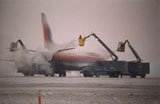Deicing/Anti-icing
Deicing/anti-icing will be required if your flight is in cold weather and moisture is present. A major concern is the accumulation of ice and snow on the wings, tail, and fuselage. Aircraft icing has contributed to several accidents in the past, and is a major safety concern. Any accumulation on the aircraft, especially the wings, can interrupt the airflow over the wings and contribute to the loss of lift that gets your aircraft flying at takeoff. Any accumulation is looked at carefully on the “walk-around”. If there is any accumulation on the aircraft, it is deiced. If there is any chance of accumulation before takeoff, it is also anti-iced.
Deicing is the removal of any snow and ice once it's on, anti-icing is the prevention of any snow and ice before it happens. There are usually two locations on the airport to handle this operation. The first is at the gate or near it. A cherry picker-type truck will pull up and spray the aircraft. The second location is the "deice pad". This is an area of the airport set aside for this special operation. It has to be relatively close to the takeoff runway so your aircraft will not taxi a long time and allow ice and snow to build up again. Most airports have the same trucks spray your aircraft at this deice pad. However, some airports will have fixed facilities to handle this operation. Additionally, and another reason that especially large airports have these deice pads is for environmental reasons. As you can imagine,the fluids used are of a propylene/ethylene glycol-based composition. They must be drained properly to reduce any potential environmental hazard.
The people that take care of your aircraft can either be that airline's employees, contracted-out service, or airport personnel. In any case, they are specially trained to correctly spray the fluid and then inspect the aircraft. Many times, their call sign is "iceman".
Right before the deice folks are ready to spray, your pilots must accomplish a deicing/anti-icing checklist. This means that the various flight surfaces are set where they can receive the fluid the best. Flaps are kept up and the horizontal stabilizer (the horizontal surface by the tail) trim is run to zero. The air conditioning system is turned off. After your aircraft is sprayed, iceman will call on the radio with the effective time that the spraying occurred, employee number, type of fluid, and mixture ratio. He also inspects the aircraft to be sure that the snow removal was complete and the aircraft is clean. The time is important because the pilots have a matrix table that will give the minutes that this particular fluid will be effective. The variables include temperature and precipitation encountered (light, heavy snow, icing, snow pellets, etc.). Once the deicing/anti-icing operation is done, your pilots will finish the checklist and reconfigure your aircraft for takeoff.
As you can see, this whole operation takes a lot of coordination among your pilots, airport tower, airport ground control, and the deicing/anti-icing personnel. The time (called "holdover time") from the final application of fluid to takeoff must be minimized and watched carefully to fit within the time allowed for that particular fluid to be most effective.



Deicing Anti-Icing Fluid Protection
Disruption of Airflow caused by Snow/Ice
Deicing Aircraft
Deicing/Anti-icing back to My Airline Flight